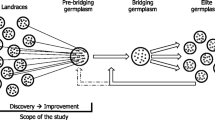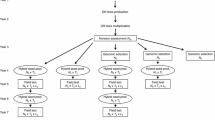Abstract
Key message
We review and propose easily implemented and affordable indicators to assess the genetic diversity and the potential of a breeding population and propose solutions for its long-term management.
Abstract
Successful plant breeding programs rely on balanced efforts between short-term goals to develop competitive cultivars and long-term goals to improve and maintain diversity in the genetic pool. Indicators of the sustainability of response to selection in breeding pools are of key importance in this context. We reviewed and proposed sets of indicators based on temporal phenotypic and genotypic data and applied them on an early maize grain program implying two breeding pools (Dent and Flint) selected in a reciprocal manner. Both breeding populations showed a significant positive genetic gain summing up to 1.43 qx/ha/year but contrasted evolutions of genetic variance. Advances in high-throughput genotyping permitted the identification of regions of low diversity, mainly localized in pericentromeric regions. Observed changes in genetic diversity were multiple, reflecting a complex breeding system. We estimated the impact of linkage disequilibrium (LD) and of allelic diversity on the additive genetic variance at a genome-wide and chromosome-wide scale. Consistently with theoretical expectation under directional selection, we found a negative contribution of LD to genetic variance, which was unevenly distributed between chromosomes. This suggests different chromosome selection histories and underlines the interest to recombine specific chromosome regions. All three sets of indicators valorize in house data and are easy to implement in the era of genomic selection in every breeding program.



Similar content being viewed by others
Data availability
The datasets analyzed in this study are not publicly available.
References
Akdemir D, Sánchez JI (2016) Efficient breeding by genomic mating. Front Genet 7:210
Akdemir D, Beavis W, Fritsche-Neto R, Singh AK, Isidro-Sánchez J (2018) Multi-objective optimized genomic breeding strategies for sustainable food improvement. Heredity 1:17
Avery PJ, Hill WG (1977) Variability in genetic parameters among small populations. Genet Res 29:193–213
Bernardo R (2014) Essentials of plant breeding. Stemma Press, Woodbury
Bernardo R (2017) Prospective targeted recombination and genetic gains for quantitative traits in maize. Plant Genome 10:2
Betrán FJ, Hallauer AR (1996) Characterization of interpopulation genetic variability in three hybrid maize populations. J Hered 87:319–328
Brisbane JR, Gibson JP (1995) Balancing selection response and rate of inbreeding by including genetic relationships in selection decisions. Theor Appl Genet 91:421–431
Browning SR, Browning BL (2007) Rapid and accurate haplotype phasing and missing-data inference for whole-genome association studies by use of localized haplotype clustering. Am J Hum Genet 81:1084–1097
Bulmer M (1971) The stability of equilibria under selection. Heredity 27:157–162
Bulmer M (1980) The mathematical theory of quantitative genetics. Oxford University Press, New York
Butler D, Cullis B, Gilmour A, Gogel B (2009) {ASReml}-R reference manual
Comstock RE, Robinson HF, Harvey PH (1949) A breeding procedure designed to make maximum use of both general and specific combining ability. Agron J 41:360–367
de los Campos G, Sorensen D, Gianola D (2015) Genomic heritability: what is it? PLoS Genet 11:e1005048
Duvick DN (1984) Chapter 2, genetic contributions to yield gains of US Hybrid Maize, 1930 to 1980. In: Genetic contributions to yield gains of five major crop plants, ASA, CSSA, 677 South Segoe Road
Duvick DN, Smith JSC, Cooper M (2004) Long-term selection in a commercial hybrid maize breeding program. Plant Breed. Rev. J Janick Ed Vol 24 Part 2 Long Term Sel. Crops Anim. Bact., Wiley, New York, pp 109–151
Eberhart SA (1964) Least squares method for comparing progress among recurrent selection methods 1. Crop Sci 4:230–231
Falconer DS, Mackay TFC (1996) Introduction to quantitative genetics, 4th edn. Longmans Green, Harlow, Essex, UK
Falke KC, Flachenecker C, Melchinger AE, Piepho H-P, Maurer HP et al (2007a) Temporal changes in allele frequencies in two European F(2) flint maize populations under modified recurrent full-sib selection. TAG Theor Appl Genet Theor Angew Genet 114:765–776
Falke KC, Maurer HP, Melchinger AE, Piepho H-P, Flachenecker C et al (2007b) Linkage disequilibrium in two European F(2) flint maize populations under modified recurrent full-sib selection. TAG Theor Appl Genet Theor Angew Genet 115:289–297
Felsenstein J (1965) The effect of linkage on directional selection. Genetics 52(2):349–363
Feng L, Sebastian S, Smith S, Cooper M (2006) Temporal trends in SSR allele frequencies associated with long-term selection for yield in maize. Maydica 51:293–300
Fischer S, Möhring J, Schön CC, Piepho H-P, Klein D et al (2008) Trends in genetic variance components during 30 years of hybrid maize breeding at the University of Hohenheim. Plant Breed 127:446–451
Fischer S, Möhring J, Maurer HP, Piepho H-P, Thiemt E-M et al (2009) Impact of genetic divergence on the ratio of variance due to specific vs. general combining ability in winter triticale. Crop Sci 49:2119–2122
Flachenecker C, Frisch M, Falke KC, Melchinger AE (2006) Trends in population parameters and best linear unbiased prediction of progeny performance in a European F2 maize population under modified recurrent full-sib selection. Theor Appl Genet 112:483–491
Ganal MW, Durstewitz G, Polley A, Bérard A, Buckler ES et al (2011) A large maize (Zea mays L.) SNP genotyping array: development and germplasm genotyping, and genetic mapping to compare with the B73 reference genome. PLoS ONE 6:e28334
Gerke JP, Edwards JW, Guill KE, Ross-Ibarra J, McMullen MD (2015) The genomic impacts of drift and selection for hybrid performance in maize. Genetics 201:1201–1211
Gianola D, de los Campos G, Hill WG, Manfredi E, Fernando R (2009) Additive genetic variability and the bayesian alphabet. Genetics 183:347–363
Gonen S, Battagin M, Johnston SE, Gorjanc G, Hickey JM (2017) The potential of shifting recombination hotspots to increase genetic gain in livestock breeding. Genet Sel Evol 49:55
Gore MA, Chia J-M, Elshire RJ, Sun Q, Ersoz ES et al (2009) A first-generation haplotype map of maize. Science 326:1115–1117
Gorjanc G, Gaynor RC, Hickey JM (2018) Optimal cross selection for long-term genetic gain in two-part programs with rapid recurrent genomic selection. Theor Appl Genet 131:1953–1966
Gusev A, Lee SH, Trynka G, Finucane H, Vilhjálmsson BJ et al (2014) Partitioning heritability of regulatory and cell-type-specific variants across 11 common diseases. Am J Hum Genet 95:535–552
Hallauer AR, Darrah LL (1985) Compendium of recurrent selection methods and their application. Crit Rev Plant Sci 3:1–33
Hill WG (1981) Estimation of effective population size from data on linkage disequilibrium 1. Genet Res 38:209–216
Hill WG, Robertson A (1966) The effect of linkage on limits to artificial selection. Genet Res 8:269–294
Hospital F, Chevalet C (1996) Interactions of selection, linkage and drift in the dynamics of polygenic characters. Genet Res 67:77–87
Inghelandt DV, Melchinger AE, Lebreton C, Stich B (2010) Population structure and genetic diversity in a commercial maize breeding program assessed with SSR and SNP markers. Theor Appl Genet 120:1289–1299
Jensen J, Su G, Madsen P (2012) Partitioning additive genetic variance into genomic and remaining polygenic components for complex traits in dairy cattle. BMC Genet 13:44
Jiao Y, Peluso P, Shi J, Liang T, Stitzer MC et al (2017) Improved maize reference genome with single-molecule technologies. Nature 546:524–527
Labate JA, Lamkey KR, Lee M, Woodman WL (1999) Temporal changes in allele frequencies in two reciprocally selected maize populations. Theor Appl Genet 99:1166–1178
Lehermeier C, de los Campos G, Wimmer V, Schön C-C (2017) Genomic variance estimates: with or without disequilibrium covariances? J Anim Breed Genet 134:232–241
Lush JL (1937) Animal breeding plans. Iowa State College Press, Iowa
Lynch M, Walsh B (1999) Evolution and selection of quantitative traits, Sunderland
MacLeod IM, Meuwissen THE, Hayes BJ, Goddard ME (2009) A novel predictor of multilocus haplotype homozygosity: comparison with existing predictors. Genet Res 91:413–426
Meuwissen TH (1997) Maximizing the response of selection with a predefined rate of inbreeding. J Anim Sci 75:934–940
Meuwissen TH, Hayes BJ, Goddard ME (2001) Prediction of total genetic value using genome-wide dense marker maps. Genetics 157:1819–1829
Nei M (1975) Molecular population genetics and evolution. Front Biol 40:I-288
Nei M (1978) Estimation of average heterozygosity and genetic distance from a small number of individuals. Genetics 89:583–590
Pérez P, de los Campos G (2014) Genome-wide regression and prediction with the BGLR statistical package. Genetics 198:483–495
Peripolli E, Munari DP, Silva MVGB, Lima ALF, Irgang R et al (2017) Runs of homozygosity: current knowledge and applications in livestock. Anim Genet 48:255–271
R Core Team (2017) R: a language and environment for statistical computing. R Foundation for Statistical Computing, Vienna
Reif JC, Gumpert F-M, Fischer S, Melchinger AE (2007) Impact of interpopulation divergence on additive and dominance variance in hybrid populations. Genetics 176:1931–1934
Rincent R, Nicolas S, Bouchet S, Altmann T, Brunel D et al (2014) Dent and Flint maize diversity panels reveal important genetic potential for increasing biomass production. TAG Theor Appl Genet Theor Angew Genet 127:2313–2331
Russell WA (1991) Genetic improvement of maize yields. Adv Agron 46:245–298
Rutkoski J (2018) Estimation of realized rates of genetic gain and indicators for breeding program assessment. bioRxiv 409342
Smith JM, Haigh J (1974) The hitch-hiking effect of a favourable gene. Genet Res 23:23–35
Sorensen D, Fernando R, Gianola D (2001) Inferring the trajectory of genetic variance in the course of artificial selection. Genet Res 77:83–94
Speed D, Balding DJ (2014) MultiBLUP: improved SNP-based prediction for complex traits. Genome Res 24:1550–1557
Tenesa A, Navarro P, Hayes BJ, Duffy DL, Clarke GM et al (2007) Recent human effective population size estimated from linkage disequilibrium. Genome Res 17:520–526
Truntzler M, Ranc N, Sawkins MC, Nicolas S, Manicacci D et al (2012) Diversity and linkage disequilibrium features in a composite public/private dent maize panel: consequences for association genetics as evaluated from a case study using flowering time. Theor Appl Genet 125:731–747
VanRaden PM (2008) Efficient methods to compute genomic predictions. J Dairy Sci 91:4414–4423
Waples RS, England PR (2011) Estimating contemporary effective population size on the basis of linkage disequilibrium in the face of migration. Genetics 189:633–644
Weir BS, Hill WG (1980) Effect of mating structure on variation in linkage disequilibrium. Genetics 95:477–488
Woolliams JA, Berg P, Dagnachew BS, Meuwissen THE (2015) Genetic contributions and their optimization. J Anim Breed Genet 132:89–99
Wright S (1931) Evolution in mendelian populations. Genetics 16:97–159
Yang J, Benyamin B, McEvoy BP, Gordon S, Henders AK et al (2010) Common SNPs explain a large proportion of the heritability for human height. Nat Genet 42:565–569
Acknowledgements
The authors thank the experimental staff at RAGT2n for managing field experiments and data extractions. This research was funded by RAGT2n and the ANRT CIFRE Grant No. 2016/1281 for AA.
Author information
Authors and Affiliations
Corresponding author
Ethics declarations
Conflict of interest
The authors declare that they have no conflict of interest. The experiments reported in this study comply with the current laws in Europe.
Additional information
Communicated by Benjamin Stich.
Publisher's Note
Springer Nature remains neutral with regard to jurisdictional claims in published maps and institutional affiliations.
Electronic supplementary material
Below is the link to the electronic supplementary material.
Rights and permissions
About this article
Cite this article
Allier, A., Teyssèdre, S., Lehermeier, C. et al. Assessment of breeding programs sustainability: application of phenotypic and genomic indicators to a North European grain maize program. Theor Appl Genet 132, 1321–1334 (2019). https://doi.org/10.1007/s00122-019-03280-w
Received:
Accepted:
Published:
Issue Date:
DOI: https://doi.org/10.1007/s00122-019-03280-w




